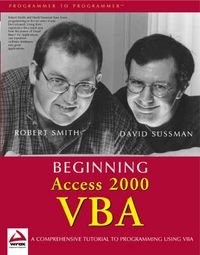
Beginning Access 2000 VBA Upplaga 1
Access 2000 is the fifth version of the hugely successful desktop database from Microsoft. When it was first released in 1992, Access immediately gained praise for its ease of use and power. Each release of Access has added features and increased usability, and with Access 2000 we now have a unified development environment for the whole of the Office 2000 suite of applications. Visual Basic for Applications (VBA) is the programming language that gives Access its real power, allowing you to automate complex tasks and create applications with more scope and flexibility than is possible with its default forms and macros. VBA has a simple syntax allowing even complete novices to learn programming with very little effort, and this book illustrates the concepts with plenty of examples and exercises.
Who is this book for?
This book is for users who already have a basic knowledge of databases and the basic Access objects, such as tables, queries, forms and reports. You now want to expand on your existing knowledge of Access and wish to learn how to program in VBA. You don't need any prior programming experience, although a basic knowledge of Access macros would be helpful.
What does this book cover?
* Constructing a substantial example application with VBA
* Mastering the foundations of Visual Basic for Applications
* Understanding the concepts behind classes and objects
* How Automation can be used to link Office applications
* Creating custom objects using the Class Module feature
* How to debug your programs and implement robust error handling
* Adding support for multiple users
* Publishing your Access database on the Internet
* How to optimize and add polish to your finished database application
Upplaga: 1a upplagan
Utgiven: 2000
ISBN: 9780764543838
Förlag: John Wiley & Sons
Format: Häftad
Språk: Engelska
Sidor: 896 st
Access 2000 is the fifth version of the hugely successful desktop database from Microsoft. When it was first released in 1992, Access immediately gained praise for its ease of use and power. Each release of Access has added features and increased usability, and with Access 2000 we now have a unified development environment for the whole of the Office 2000 suite of applications. Visual Basic for Applications (VBA) is the programming language that gives Access its real power, allowing you to automate complex tasks and create applications with more scope and flexibility than is possible with its default forms and macros. VBA has a simple syntax allowing even complete novices to learn programming with very little effort, and this book illustrates the concepts with plenty of examples and exercises.
Who is this book for?
This book is for users who already have a basic knowledge of databases and the basic Access objects, such as tables, queries, forms and reports. You now want to expand on your existing knowledge of Access and wish to learn how to program in VBA. You don't need any prior programming experience, although a basic knowledge of Access macros would be helpful.
What does this book cover?
* Constructing a substantial example application with VBA
* Mastering the foundations of Visual Basic for Applications
* Understanding the concepts behind classes and objects
* How Automation can be used to link Office applications
* Creating custom objects using the Class Module feature
* How to debug your programs and implement robust error handling
* Adding support for multiple users
* Publishing your Access database on the Internet
* How to optimize and add polish to your finished database application
Begagnad bok (0 st)
Varje vecka tillkommer tusentals nya säljare. Bevaka boken så får du meddelande när den finns tillgänglig igen.



